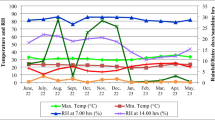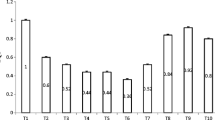Abstract
According to the principles and methods of ecology and system engineering, we set up an evaluation indicator system for multi-component and multiple cropping systems, evaluated the comprehensive benefits of multi-component and multiple cropping systems using grey relation clustering analysis and screened out the optimized model based on research done in the upland red soil in Jiangxi Agricultural University from 1984 to 2004. The results show that the grey relation degree of “cabbage/potato/maize — sesame” was the highest among 23 multi-component and multiple cropping systems and was clustered into the optimized system. This indicates that “cabbage/potato/maize — sesame” can bring the best social, economic and ecological benefits, increase product yield and farmers’ income and promote sustainable development of agricultural production. Therefore, it is suitable for promotion on upland red soil. The grey relation degree of “canola/Chinese milk vetch/maize/mung bean/maize” was second, which is suitable for implementation at the city outskirts. In conclusion, these two planting patterns are expected to play important roles in the reconstruction of the planting structure and optimization of the planting patterns on upland red soil.
Similar content being viewed by others
References
Deng J L (1987). Primary Methods of Grey Systems. Wuhang: Huazhong University of Science and Technology Press, 35–47 (in Chinese)
Gollar R G., Patil V C (1997). Studies on maize based cropping systems under simultaneous and staggered planting of intercrops. Karnataka Journal of Agricultural Sciences, 10(3): 648–652
He Y Q, Wu D F, Li C L, Wang X X (2004). Nutrient and water cycling in red soils with different planting systems and their management. Chinese Journal of Applied Ecology, 15(9): 1547–1551 (in Chinese)
Huang G Q (2002). The way and directions of adjustment of agriculture structure in the South of China. Chinese Agricultural Science Bulletin, 18(4): 127–129 (in Chinese)
Huang G Q (2002). Views on agricultural ecology and its developing trend. Acta Agriculturae Universitatis Jiangxiensis, 24(5): 656–660 (in Chinese)
Huang G Q, Zhang X G, Ke J G (1995). The establishment and application of a comprehensive evaluation criteria set for cropping systems. In:CAS ecological experiment station. Research on Ecological system of Red soil (III). Beijing: China Agriculture Science and Technology Press, 65–78 (in Chinese)
Huang X X, Sheng M X (1993). Multifactorial evaluation of economic and ecologic effects of cropping systems with application of relational grade analysis. Journal of Jiangsu Agricultural College, 14(2): 31–36 (in Chinese)
Jat R L, Gaur B L, Kumar S, Kulhari R K (1998). Effects of weed management, fertilizers and Rhizobium inoculation on growth, yield attributes of maize (Zeamays) and soybean (Glycine max) under maize+soybean intercropping systems. Indian Journal of Agronomy, 43(1): 23–26
Liu H Z, Zhao Q J, Zheng J C, Yuan C W (1996). Evaluations on multicomponent-multiple cropping patterns and their comprehensive benefits of along Changjiang River Economic Zone in Jiangsu. Rural Eco-Environment, 12(4): 19–23 (in Chinese)
Liu Z C, Zhong S F (1990). AHP and Fuzzy comprehensive evaluation of farming systems. Acta Agriculturae Universitatis Jiangxiensis, 12(1): 65–72 (in Chinese)
Muza L (1996). Selecting green-manure legumes for relay and intercropping systems with maize on sandy soils in Zimbabwe. In: Buckles D, Etexa A, Osiname O, Galisa M, Galiano G, eds. Cover Crops in West Africa: Contributing to Sustainable Agriculture, Ottawa: IDRC, 1–3
Song S B, Cai H J (2004). Comprehensive quantitative assessment models for ecological environment in arid area. Acta Ecological Sinica, 24(11): 2509–2515 (in Chinese)
Wang L C, Jia Z K, Jiang J, Ren S C (2000). Study on the multiple cropping patterns with high efficiency in the irrigated farmland in semi-arid areas of south Ningxia. Acta Agriculturae Boreali-occidentalis Sinica, 9(4): 58–62 (in Chinese)
Wu D F, He Y Q (2004). Comprehensive evaluation of the eco-agriculture in Yujiang county, Jiangxi province. Acta Pedologica Sinica, 41(5): 819–822 (in Chinese)
Wu G, Wei J, Zhang P, Zhao J Z (2002). Benefit assessment of agroforestry ecosystems in the Three Gorges Reservoir Area. Acta Ecological Sinica, 22(2): 232–239 (in Chinese)
Wu J C, Wang Q J, Kou C L, Kong X X, Ren SK (1999). Evaluation of Comprehensive Benefit on Cropping Patterns in Kaifeng Sandy Experimental Region. Chinese Journal of Ecology, 18(1): 3–8 (in Chinese)
Wu L F, Ouyan Z, Tang D Y(2004). The quantitative assessment of ago-ecosystem health on a regional dimension. Acta Ecological Sinica, 24(12): 2740–2748 (in Chinese)
Xie Z M, Lu J (1998). Degradation process of red soil and its niche. Chinese Journal of Applied Ecology, 9(6): 669–672 (in Chinese)
Xu M J, Ge X D, Zhang Y Q, Peng B Z (2001). An index system for the sustainability assessment of cultivated lands and a case study of Wujiang city. Acta Pedologica Sinica, 38(3): 275–284 (in Chinese)
Xu Z B, Li Y L, Ma Z Q, Wang G, Guo Q (1995). Applying greyrelation analysis to study on grain-vegetable construction of space-growing model. Journal of Biomathematics, 12(4): 224–228 (in Chinese)
Ye F, Huang G Q (2000). Comprehensive appraisal of effects of several maize-based cropping systems on upland red soil. Acta Agriculturae Jiangxi, 12(3): 1–6 (in Chinese)
Zhang H Q, Li J Y, Niu D (2003). Study on spatial optimization allocation of land use in the typical red soil hilly region in south China. Acta Geographica Sinica, 58(5): 668–676 (in Chinese)
Zhao Q G (2002). Mechanism, temporal-spatial changes and controlling countermeasures of soil degradation in hilly red soil region of southeastern China. Beijing: Science Press, 378–465 (in Chinese)
Zhao Q G (2002). The Red Soil Material Cycling and its Regulation. Beijing: Science Press, 41–165
Zhou B Z, Yang H, Zhou S L, Zhang Z Y, Zhang H (2002). The eco-environmental efficiencies and its control in agricultural development in hilly region of red soil. Areal Research and Development, 12(4): 14–19 (in Chinese)
Author information
Authors and Affiliations
Corresponding author
Additional information
__________
Translated from Acta Ecologica Sinica, 2006, 26(8): 2532–2539 [译自: 生态学报]
Rights and permissions
About this article
Cite this article
Huang, G., Liu, X., Liu, L. et al. Comprehensive evaluation of multiple cropping systems on upland red soil. Front. Biol. China 3, 344–350 (2008). https://doi.org/10.1007/s11515-008-0047-5
Published:
Issue Date:
DOI: https://doi.org/10.1007/s11515-008-0047-5




